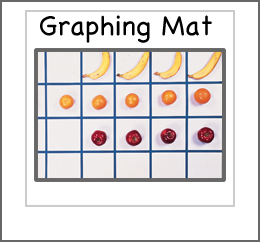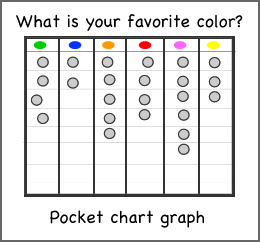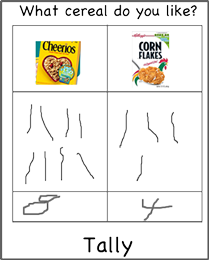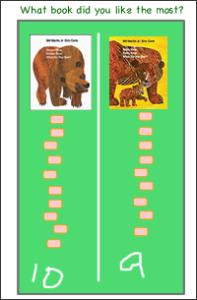Graphing activities for preschool and kindergarten include collecting data and organizing it in a variety of ways.
When children ask their friends to choose which cereal they prefer from a picture of two different cereals, then put a tally mark under the cereal picture, and finally count how many tally marks are in each column, they are not only graphing but are also working with statistics or data analysis.
There are lots of fun things to do in this area of math and the activities integrate well with science and literacy concepts.
In the cereal image the child has cut pictures out of a grocery ad and glued them on his tally sheet, then interviewed her/his friends to find out which cereal she/he liked the most.
Statistics, probability and graphing activities – what do children need to know?
Children should have experiences:
- collecting information
- counting and making tallies
- surveying peers
- sorting objects
- making graphs with real things and making picture graphs
- reading graphs
- making observations from a graph
- working with tally marks and comparing their results with a friend’s results
- asking questions about graph results
- using the terms “never, sometimes, always”
- graphing in kindergarten
As always, depending on what age children you are teaching and where you live, the skills requirements will vary slightly.
Graphing Mat Ideas

1. Make your own…
A plain, heavy vinyl picnic table cover makes a good mat for graphing larger items. Strips of colored hockey tape make the grids. Usually 3 columns and 12 rows are enough.
2. Buy ready-made…
Commercial mats are readily available and come in durable vinyl. Some feature a blue 3 x 10 array on one side and a red 4 x 12 array on the reverse. They provide a way to graph, count, sort, and compare real objects or pictures.
Using Pocket Charts
 A pocket chart can be used to quickly graph smaller items. The image on the left demonstrates how to put a heading in the top of the pocket chart, then 6 different colored blocks at the top of what will be columns.
A pocket chart can be used to quickly graph smaller items. The image on the left demonstrates how to put a heading in the top of the pocket chart, then 6 different colored blocks at the top of what will be columns.
Children take turns inserting a colored block underneath the color they like the most, creating a column.
Pocket charts are also great for creating graphs with other small real objects, such as graphing my favorite colored Smartie™.
Magnetic chalk or white boards for graphing activities
- Magnetic chalk or white boards make it easy to create spontaneous graphs.
- Draw 2 pictures on the board, draw a line between them and have children place a small fridge magnet under their favorite category.
- In the image on the right, book jackets are clipped to the magnetic chalkboard and the children have placed their magnet under their favorite story.
- Book covers can be photocopied.
- Children can then count how many in each row and compare the amounts.
Introducing Graphs
Graphing is taught in three stages:
Stage 1 – Begin by placing real things on a graphing mat or in a pocket chart
Stage 2 – Introduce pictorial graphs – place pictures that represent the real objects on a graph
Stage 3 – Symbolic graphs – using words, numbers or symbols to represent the data collected. No rush for this in kindergarten!
Graphing activities are fun to do in class and there are endless things to graph throughout the year. Themes, holidays and everyday items all provide ideas for things to compare or sort.
Benefits of teaching with graphing activities
- Graphs make counting and comparing meaningful
- Graphs provide opportunities to bring numbers, letters, letter sounds and other literacy skills to the children’s attention
- Graphing activities in the early grades are generally limited to real and pictorial graphs.

